Category: Cardiology
Posted: 6/2/2013 by Semhar Tewelde, MD
(Updated: 12/15/2025)
Click here to contact Semhar Tewelde, MD
Category: Pharmacology & Therapeutics
Keywords: cellulitis, cephalexin, sulfamethoxazole/trimethoprim, Bactrim, streptococcus (PubMed Search)
Posted: 5/20/2013 by Bryan Hayes, PharmD
(Updated: 5/31/2013)
Click here to contact Bryan Hayes, PharmD
Background
In the current era of community-acquired MRSA (CA-MRSA), most of our outpatient treatment options for cellulitis aim to cover MRSA. Choices include sulfamethoxazole/trimethoprim (SMZ-TMP), doxycycline, linezolid, and clindamycin (depending on local susceptibility patterns).
A New Study
Take Home Clinical Points
Pallin DJ, et al. Clinical Trial: Comparative Effectiveness of Cephalexin Plus Trimethoprim-Sulfamethoxazole Versus Cephalexin Alone for Treatment of Uncomplicated Cellulitis: A Randomized Controlled Trial. Clinical Infectious Diseases 2013;56(12):1754-62. [PMID 23457080]
Follow me on Twitter (@PharmERToxGuy)
Category: Toxicology
Keywords: quetiapine, olanzapine, risperidone (PubMed Search)
Posted: 5/30/2013 by Fermin Barrueto
(Updated: 12/15/2025)
Click here to contact Fermin Barrueto
Hyperglycemia in the setting of antipsychotic use has been reported mostly with olanzapine (Zyprexa) but does occur with other antipsychotics. A recent study from the NYC medical examiner's office details 17 deaths of DKA due to antipsychotics and found that (from highest to lowest incidence) quetiapine > olanzapine > risperidone were the atypical antipsychotics found with these deaths.
Remember hyperglycemia occurs with patients on antipsychotics and can lead to hyperglycemia hyperosmolar coma or DKA. Both can be lethal.
Fatal Diabetic Ketoacidosis and Antipsychotic Medication.
Ely SF, Neitzel AR, Gill JR.
J Forensic Sci. 2012 Dec 27. doi: 10.1111/1556-4029.12044.
Category: International EM
Posted: 5/30/2013 by Walid Hammad, MD, MBChB
Click here to contact Walid Hammad, MD, MBChB
Background Information:
Each year, an estimated 50 million travelers from Western countries visit tropical regions all over the world.
Given the potentially serious consequences for the patients and, their close contacts and healthcare workers it is important that life threatening tropical diseases are swiftly diagnosed.
Pertinent Study Design and Conclusions:
- Descriptive analysis of acute and potentially life threatening tropical diseases among 82,825 ill western travelers reported to GeoSentinel from June of 1996 to August of 2011.
- Of these travelers, 3,655 (4.4%) patients had an acute and potentially life threatening disease.
- The four most common conditions being falciparum malaria (76.9%), typhoid fever (11.7%), paratyphoid fever (6.4%), and leptospirosis (2.4%).
Bottom Line:
Western physicians seeing febrile and recently returned travelers from the tropics need to consider a wide profile of potentially life threatening tropical illnesses, with a specific focus on the most likely diseases described in this case series.
University of Maryland Section of Global Emergency Health
Author: Walid Hammad, MB ChB
Jensenius M, Han PV, Schlagenhauf P, Schwartz E, Parola P, Castelli F, von Sonnenburg F, Loutan L, Leder K, Freedman DO; GeoSentinel Surveillance Network. Acute and potentially life-threatening tropical diseases in western travelers—a GeoSentinel multicenter study, 1996-2011. Am J Trop Med Hyg. 2013 Feb; 88(2):397-404
Category: Critical Care
Posted: 5/28/2013 by Mike Winters, MBA, MD
(Updated: 12/15/2025)
Click here to contact Mike Winters, MBA, MD
End-expiratory Occlusion Test
Monnet X, Teboul JL. Assessment of volume responsiveness during mechanical ventilation: recent advances. Critical Care 2013; 17:217.
Category: Visual Diagnosis
Posted: 5/27/2013 by Haney Mallemat, MD
Click here to contact Haney Mallemat, MD
9 month-old presents with wheezing and the CXR is shown below. What's the diagnosis?
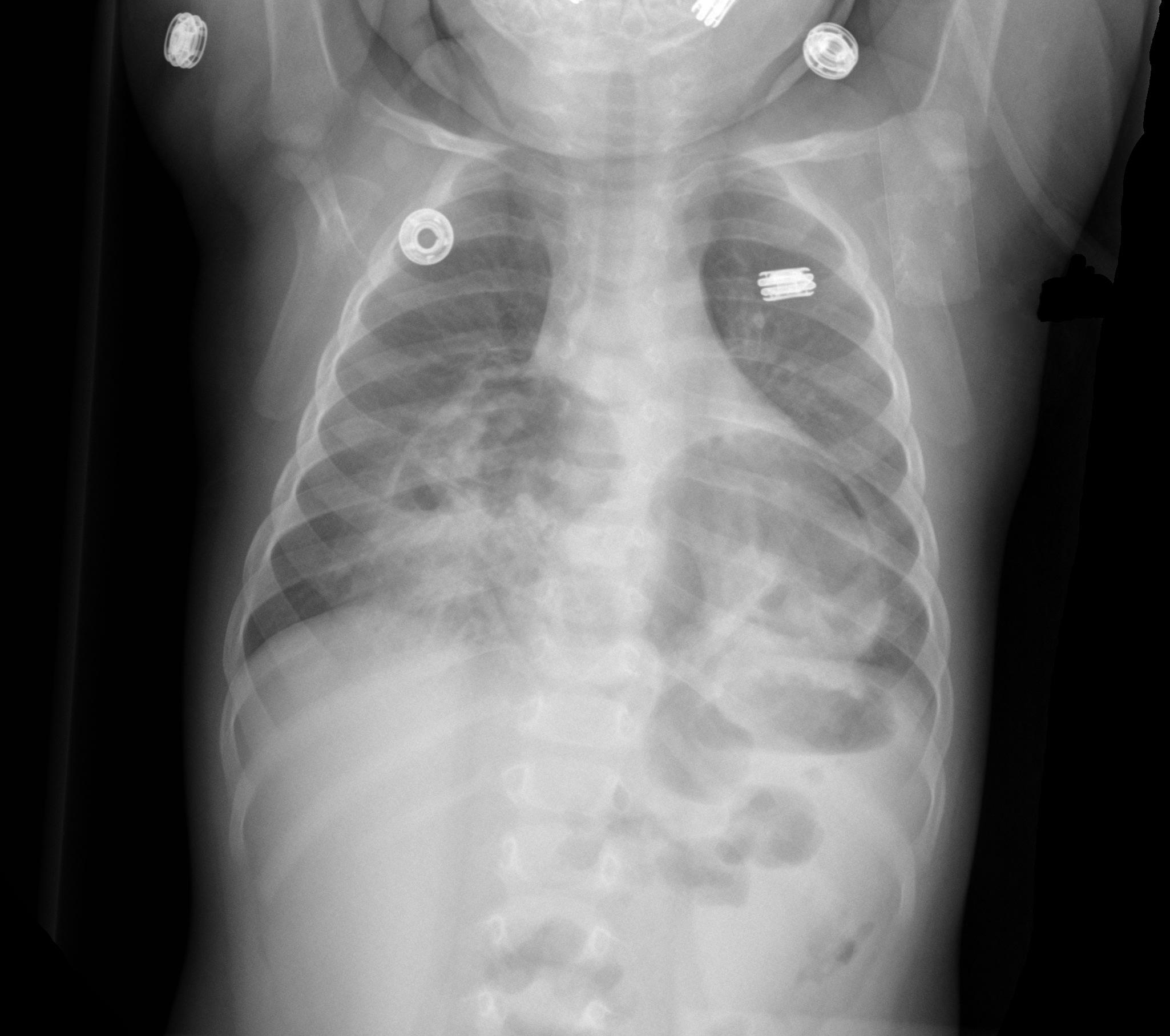
Congenital anterior diaphragmatic defects with herniated bowel.
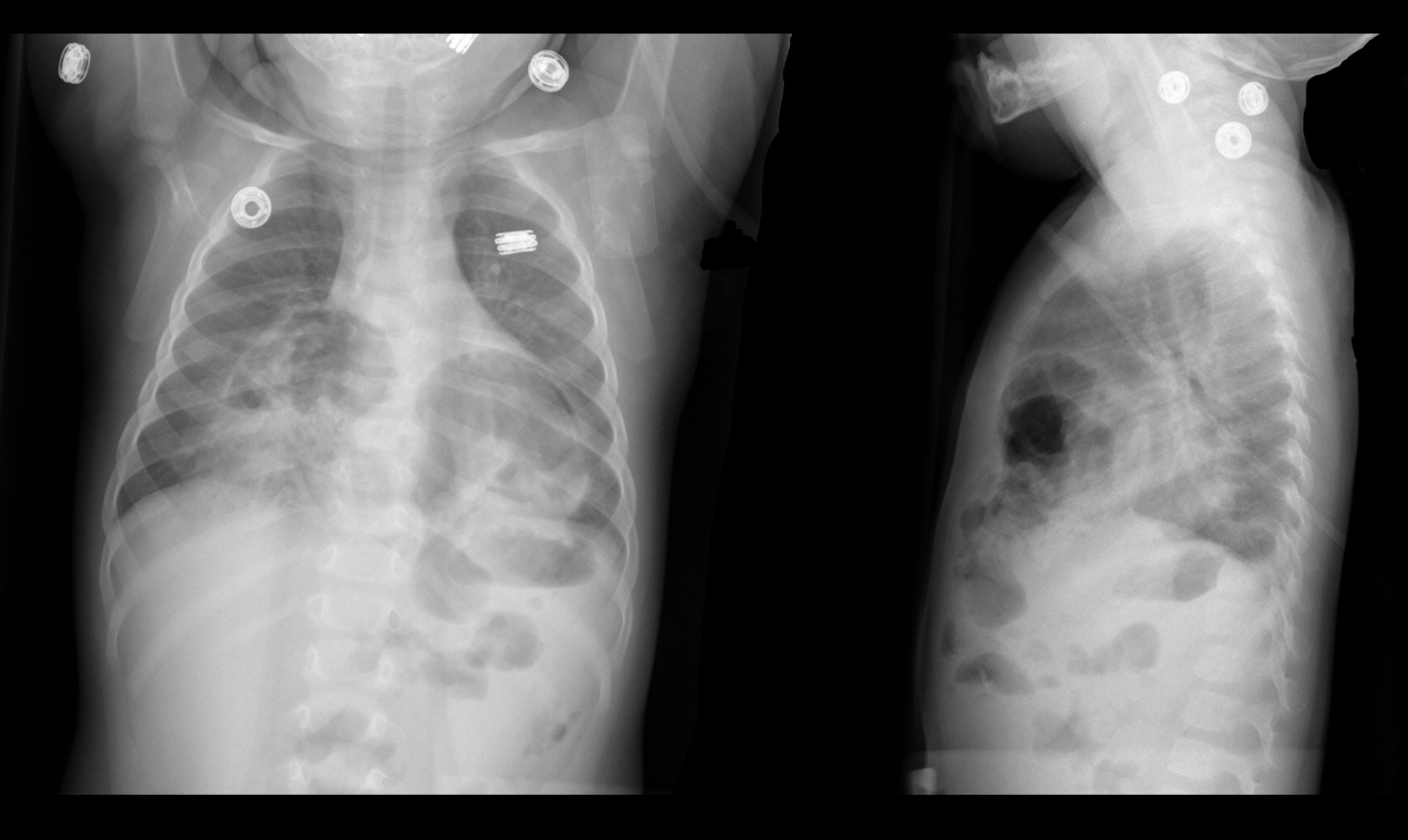
Follow me on Twiter (@criticalcarenow) or Google+ (+criticalcarenow)
Category: Cardiology
Posted: 5/26/2013 by Semhar Tewelde, MD
(Updated: 12/15/2025)
Click here to contact Semhar Tewelde, MD
Reynolds H. Myocardial infarction without obstructive coronary artery disease. Curr Opin Cardiol 2012, 27:655–660
Category: Orthopedics
Keywords: Frozen shoulder, adhesive capsulitis (PubMed Search)
Posted: 5/25/2013 by Brian Corwell, MD
(Updated: 12/15/2025)
Click here to contact Brian Corwell, MD
Adhesive capsulitis aka frozen shoulder
idiopathic loss of BOTH active and passive motion (this is a significant reduction of at least 50%)
Motion is stiff and painful especially at the extremes
Occurs due to thickening and contracture of the shoulder capsule
Affects patients between the ages of 40 and 60
Diabetes is the most common risk factor
Imaging is normal and only helpful to rule out other entities such as osteophytes, loose bodies etc.
Treatment includes NSAIDs, moist heat and physical therapy.
Patients should expect a recovery period of 1-2 years!
Category: Pediatrics
Posted: 4/26/2013 by Mimi Lu, MD
(Updated: 5/24/2013)
Click here to contact Mimi Lu, MD
Ultrasound findings of appendicitis
Ultrasound images:
http://www.youtube.com/watch?v=d9jKM6x52nk
http://sonocloud.org/watch_video.php?v=MWHM3D7KD25H
http://sonocloud.org/watch_video.php?v=54862AYWGHGA
Category: Toxicology
Keywords: intralipid, arrest, lipid (PubMed Search)
Posted: 5/23/2013 by Fermin Barrueto
(Updated: 12/15/2025)
Click here to contact Fermin Barrueto
Utilizing 20% lipid emulsion at a dose of 1.5 mL/kg (100 mL Bolus) IV with repeat in 15 minutes in no response is being recommended in patients hemodynamic instabiity due to poisoning.
Probably more effective in lipophilic drugs is a current theory for the mechanism of action - the "lipid sink". The idea is that the lipids envelope the drug pulling it off its receptors or sequestering it in the intravascular space. A recent paper has added another mechanism - direct inotropic and lusiptropic effects.(1)
Also, if you think the therapy is experimental, think again. Another recent paper surveyed Poison Control Centers and found 30/45 Poison Centers in the US have a defined protocol for utilization of lipid emulsion therapy. The PCCs are recommending it more.(2)
What was once considered just a purely experimental therapy only used at the very end of code is becoming more mainstream. Comfort with its safety profile and anectodotal effiicacy continues to mount.
1. Fettiplace MR, Ripper R, Lis K, Lin B, Lang J, Zider B, Wang J,
Rubinstein I, Weinberg G. Rapid Cardiotonic Effects of Lipid Emulsion
Infusion. Crit Care Med. 2013 Mar 25. [Epub ahead of print]
2. Christian MR, Pallasch EM, Wahl M, Mycyk MB. Lipid Rescue 911: Are
Poison Centers Recommending Intravenous Fat Emulsion Therapy for
Severe Poisoning? J Med Toxicol. 2013 May 10. [Epub ahead of print]
Category: International EM
Posted: 5/22/2013 by Walid Hammad, MD, MBChB
Click here to contact Walid Hammad, MD, MBChB
Clinical Presentation:
- A 40-year-old Hispanic man was admitted to the hospital after being found unconscious. He had a 2-day history of disorientation that manifested itself as his being unable to recognize family members.
- Upon admission he regained consciousness, becoming alert and oriented, but developed urinary retention and was unable to move or feel his lower extremities.
- Spinal MRI (with and without gadolinium) showed the spinal cord to be abnormally diffuse, with swelling and edema in the cervicothoracic region.
Diagnosis:
- After an extensive work up for lymphoma and CNS infection, he was discovered to have toxoplasmosis and was found to be HIV positive, which was previously undiagnosed.
Discussion:
- Approximately 10% of patients with AIDS present with some neurological deficit as their initial complaint, and up to 80% will have CNS involvement during the course of their disease.
- Myelitis is a known complication of AIDS and is occasionally the initial complaint.
The incidence of myelopathy may be as high as 20%, with 50% of the cases reported post-mortem
- Toxoplasmosis is the most common cause of cerebral mass lesions in patients with AIDS
Occurring in 3–10% of patients in the United States and in up to 50% of AIDS patients in Europe, Latin America, and Africa
Bottom Line:
New neurological deficit in any patient should raise suspicion of HIV infection
Most patients with AIDS that present with evolving myelopathy, characterized by extremity weakness, sensory involvement, spinal cord enlargement, enhancing lesions in brain or spinal cord CT or MRI, have toxoplasmic myelitis
University of Maryland Section of Global Emergency Health
Author: Terrence Mulligan DO, MPH
"Spinal cord toxoplasmosis as an unusual presentation of AIDS: case report and review of the literature", Int J Emerg Med (2010) 3:439–442
Category: Critical Care
Posted: 5/21/2013 by Haney Mallemat, MD
Click here to contact Haney Mallemat, MD
The Macklin Effect
Pneumomediastinum (click here for image) may be caused by many things:
The "Macklin Effect" is typically a self-limiting condition leading to spontaneous pneumomediastinum and massive subcutaneous emphysema after the following:
Pneumomediastinum secondary to the Macklin effect frequently leads to an extensive workup to search for other causes of mediastinal air. Although, no consensus exists regarding the appropriate workup, the patient's history should guide the workup to avoid unnecessary imaging, needless dietary restriction, unjustified antibiotic administration, and prolonged hospitalization.
Treatment of spontaneous pneumomediastinum includes:
Follow me on Twitter (@criticalcarenow) or Google+ (+criticalcarenow)
Category: Visual Diagnosis
Posted: 5/20/2013 by Haney Mallemat, MD
Click here to contact Haney Mallemat, MD
30 year-old male presents with right wrist pain after falling off his bicycle. What's the diagnosis?
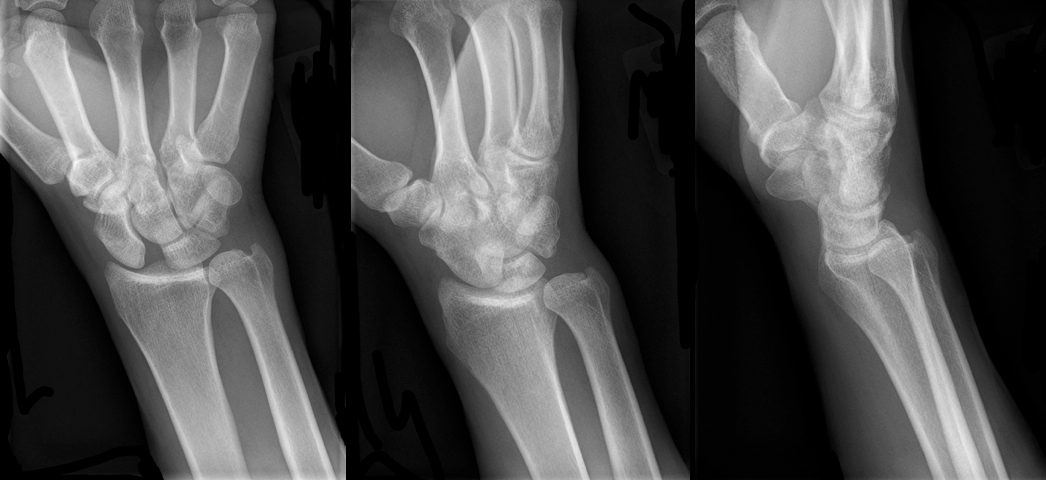
Scapholunate dislocation
Scapholunate Dislocation (a.k.a. “Terry Thomas” or “David Letterman” sign)
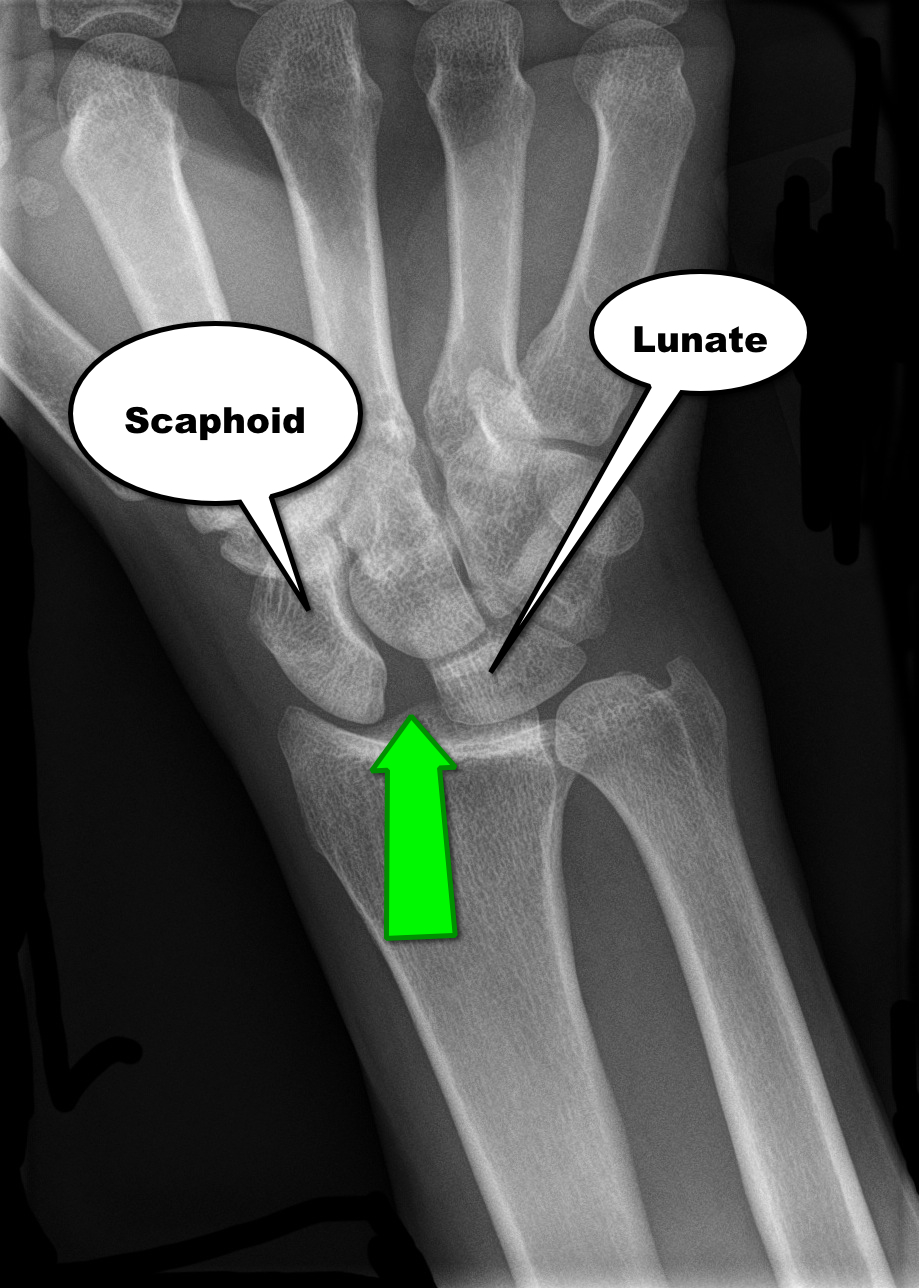

Follow me on Twitter (@criticalcarenow) or Google+ (+criticalcarenow)
Category: Cardiology
Posted: 5/19/2013 by Semhar Tewelde, MD
(Updated: 12/15/2025)
Click here to contact Semhar Tewelde, MD
Than M, Cullen L. 2-Hour Accelerated Diagnostic Protocol to Assess Patients With Chest Pain Symptoms Using Contemporary Troponins as the Only Biomarker. J Am Coll Cardiol. 2012;59(23):2091-2098
Category: Orthopedics
Keywords: Fabella (PubMed Search)
Posted: 5/18/2013 by Michael Bond, MD
(Updated: 12/15/2025)
Click here to contact Michael Bond, MD
Fabella Syndrome
The fabella is a sesamoid bone that is embedded in the tendon of the gastrocnemius muscle where the fibers of the popliteus, arcuate complex and the fibular-fabellar ligament attach.
Fabella syndrome is a painful condition of the posterolateral knee that is exacerbated when the knee is extended. The pain can be exacerbated by palpation of the fabella and if it is compressed against the condyles. The condition is most common in adolescence, but occurs in adults too.
Consider this condition in patients with posterolateral knee pain, which can also be due to tears of the posterior horn of the lateral meniscus, and tendonitis of the lateral head of the gastrocnemius.
Category: International EM
Posted: 5/15/2013 by Walid Hammad, MD, MBChB
Click here to contact Walid Hammad, MD, MBChB
General information:
· Salmonella typhi – transmission through fecal-oral, contaminated food, human carriers
· Most cases in the US acquired abroad – Africa, Latin American, Asia
· Vaccine available – not life-long immunity, need 1-2 weeks to take effect
Clinical Presentation:
· sustained high fever (103-104)
· Faget sign: fever and bradycardia (also seen in yellow fever, atypical pneumonia, tularemia, brucellosis, Colorado tick fever))
· Abdominal pain, GI bleed/perforation, hepatosplenomegaly, delirium
· “Rose spots” – erythematous macular rash over chest and abdomen
· Without treatment sx can resolve after 3-4 weeks, mortality from secondary infections 12-30%
Diagnosis:
· Pan-culture for S. typhi
· Serologic: Widal test (negative for 1st week of symptoms, 7-14 days to result)
Treatment:
· Abx: amoxicillin, trimethoprim-sulfamethoxazole, and ciprofloxacin
· MDR typhoid: ceftriaxone or Azithromycine 1st line
Bottom Line:
· Get vaccinated if travelling to endemic areas 1-2 weeks before travel
· Suspect in travelers to endemic areas with sustained high fevers
· Spontaneous resolution does occur but may become carriers without abx
Famous victims or Typhoid fever:
· Wilbur Wright (Wright brothers)
· Prince Albert (Queen Victoria’s husband)
· Hakaru Hashimoto (discovered Hashimoto’s thyroiditis)
· Abigail Adams (1st Lady, wife of John Adams)
University of Maryland Section of Global Emergency Health
Author: Veronica Pei, MD
http://www.cdc.gov/nczved/divisions/dfbmd/diseases/typhoid_fever/technical.html#risk
Category: Critical Care
Posted: 5/14/2013 by Mike Winters, MBA, MD
(Updated: 12/15/2025)
Click here to contact Mike Winters, MBA, MD
Monitoring Hyperosmolar Therapy
Hinson HE, Stein D, Sheth KN. Hypertonic Saline and Mannitol in Critical Care Neurology. J Intensive Care Med 2013; 28:3-11.
Category: Visual Diagnosis
Posted: 5/13/2013 by Haney Mallemat, MD
Click here to contact Haney Mallemat, MD
60 year-old male with a history of pulmonary fibrosis presents to the Emergency Department after a lung biopsy. He is complaining of facial swelling and dyspnea. What's the diagnosis?
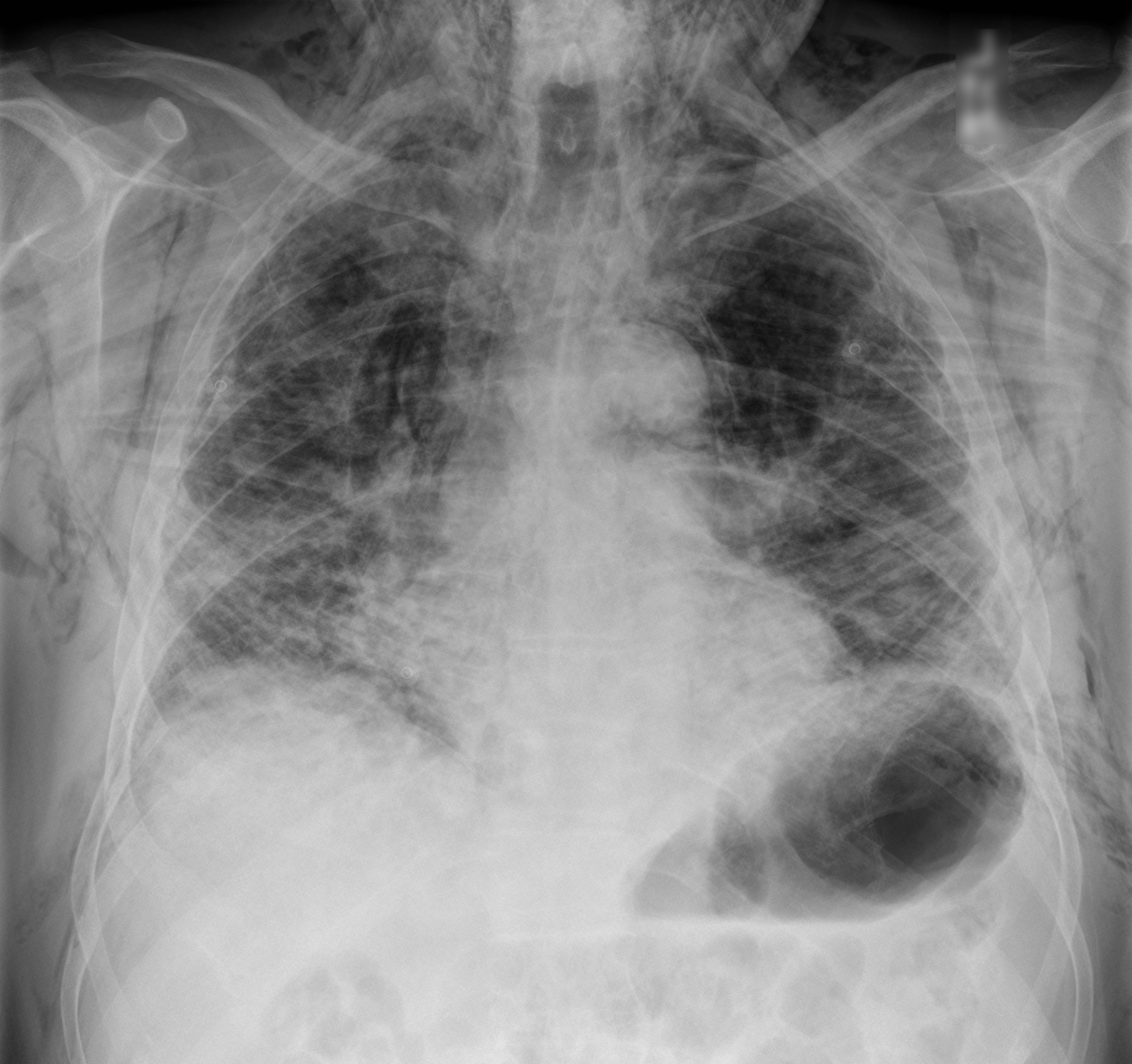
Answer: Massive subcutaneous emphysema
Click here
Follow me on Twitter (@criticalcarenow) or Google+ (+criticalcarenow)
Category: Cardiology
Keywords: CRS (PubMed Search)
Posted: 5/9/2013 by Semhar Tewelde, MD
(Updated: 5/12/2013)
Click here to contact Semhar Tewelde, MD
Ronco C, et al. Cardiorenal Syndrome Type I: Pathophysiological Crosstalk Leading to Combined Heart and Kidney Dysfunction in the Setting of Acutely Decompensated Heart Failure. JACC Vol. 60, No. 12, 2012
Category: Airway Management
Keywords: spine, back pain, osteophyte (PubMed Search)
Posted: 5/11/2013 by Brian Corwell, MD
(Updated: 12/15/2025)
Click here to contact Brian Corwell, MD
Diffuse Idiopathic Skeletal Hyperostosis
aka 1) ankylosing hyperostosis, 2) Vertebral osteophytosis
Large amount of osteophyte formation in the spine, confluent, spanning 3 or more disks
Most commonly seen in the thoracic and thoracolumbar spine.
Osteophytes follow the course of the anterior longitudinal ligaments.
2:1 male to female ratio. Most patients >60yo.
Sx's: Longstanding morning and evening spine stiffness.
PE: Spinal stiffness with flexion and extension.
Dx: plain films
Tx: NSAIDs and physical therapy
http://www.learningradiology.com/caseofweek/caseoftheweekpix2013%20538-/cow542-1arr.jpg
